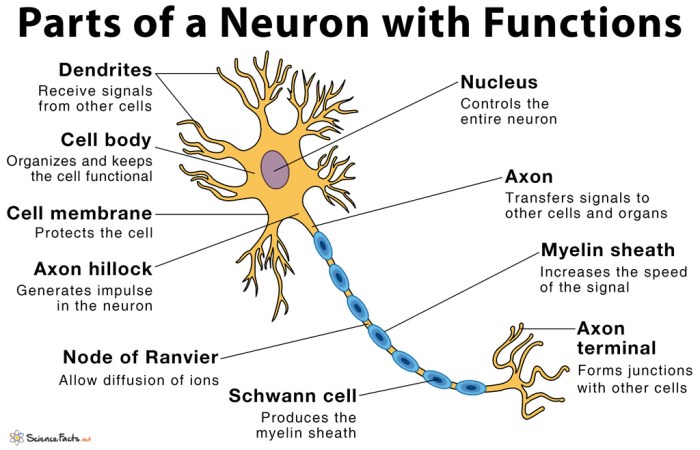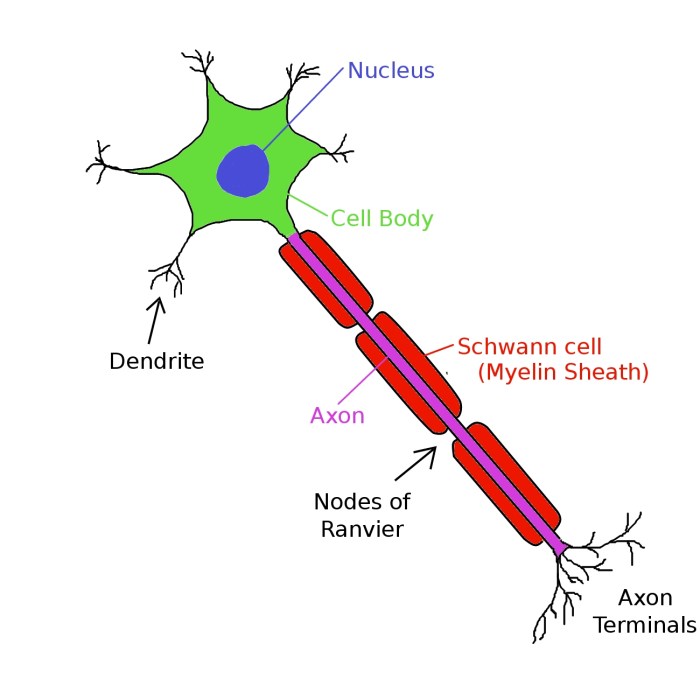Correctly label the following anatomical features of a nerve. – Correctly labeling the anatomical features of a nerve is a fundamental skill in the fields of neuroscience, anatomy, and medicine. This comprehensive guide provides a detailed overview of the structure and function of a nerve, along with step-by-step instructions on how to accurately identify and label its anatomical components.
Understanding the intricacies of nerve anatomy is crucial for accurate diagnosis, effective treatment, and groundbreaking research advancements.
Nerves are essential communication pathways within the nervous system, transmitting electrical impulses to and from the brain and spinal cord. They consist of specialized cells called neurons, which are surrounded by protective layers of connective tissue. Each nerve has a unique set of anatomical features that can be identified and labeled using standardized terminology.
Anatomical Features of a Nerve

Nerves are essential components of the nervous system, transmitting electrical impulses throughout the body to control movement, sensation, and bodily functions. Each nerve is composed of multiple specialized structures that contribute to its function.
The main anatomical features of a nerve include:
- Endoneurium:The innermost layer surrounding individual nerve fibers, providing support and protection.
- Perineurium:A thin, cellular layer that surrounds groups of nerve fibers, forming fascicles.
- Epineurium:The outermost layer of connective tissue that envelops the entire nerve.
- Schwann Cells:Specialized glial cells that wrap around nerve fibers, forming the myelin sheath.
- Myelin Sheath:A lipid-rich insulating layer that surrounds some nerve fibers, increasing conduction velocity.
- Nodes of Ranvier:Unmyelinated gaps along the myelin sheath, allowing for saltatory conduction.
- Axon:The long, cylindrical extension of a nerve cell that transmits electrical impulses.
- Dendrites:Short, branched extensions of a nerve cell that receive electrical impulses.
Labeling Anatomical Features of a Nerve
Correctly labeling the anatomical features of a nerve is crucial for understanding its structure and function. The following steps provide a guide to accurate labeling:
- Identify the main nerve trunk and its branches.
- Locate the epineurium and trace it along the nerve’s length.
- Dissect away the epineurium to reveal the fascicles.
- Identify the perineurium surrounding each fascicle.
- Tease apart the fascicles to visualize individual nerve fibers.
- Use a microscope to observe the Schwann cells and myelin sheath.
- Locate the nodes of Ranvier along the myelin sheath.
- Identify the axons and dendrites extending from the nerve cell bodies.
Importance of Correct Labeling, Correctly label the following anatomical features of a nerve.
Accurate labeling of nerve anatomical features is essential for several reasons:
- Accurate Diagnosis:Correct labeling allows for precise identification of nerve damage or abnormalities, aiding in accurate diagnosis.
- Effective Treatment:Understanding the nerve’s anatomy guides appropriate treatment strategies, such as nerve repair or decompression.
- Neuroscience Advancements:Correct labeling has enabled researchers to study nerve structure and function, leading to advancements in understanding neurological disorders.
Applications of Correct Labeling
Correct labeling of nerve anatomical features finds applications in various fields:
- Research:In neuroscience research, accurate labeling is essential for studying nerve development, regeneration, and pathology.
- Clinical Practice:Surgeons and physicians use correct labeling to guide nerve repair surgeries, biopsies, and diagnostic procedures.
- Education:Medical students and healthcare professionals rely on accurate labeling to understand nerve anatomy and its clinical implications.
FAQ Compilation: Correctly Label The Following Anatomical Features Of A Nerve.
Why is it important to correctly label the anatomical features of a nerve?
Correct labeling ensures accurate communication among healthcare professionals, facilitates precise diagnosis and treatment, and contributes to advancements in neuroscience research.
What are the key anatomical features of a nerve?
Key features include the neuron, myelin sheath, Schwann cells, endoneurium, perineurium, and epineurium.
How can I practice labeling the anatomical features of a nerve?
Use labeled diagrams, interactive simulations, and physical models to enhance your understanding and practice.

